As for the stuff that this episode is more specifically about, let’s start with the orphanage. It’s usually a good idea to pay special attention to the parts of Cowboy Bebop that seem a little pointless, and all of this business with the horrifyingly creepy children and the comically pleasant nun caretaker has nothing to do with anything from a plot perspective. Oh sure, the nun hands Edward a picture of her father and tells her that he’s been coming around asking about her, prompting her to put the bounty on his head so that Spike and Jet can track him down. But they could have done that any old way – why not have the picture get mailed to the BeBop, like Faye’s videotape? Why not have Appledelhi coincidentally meet them in Singapore? But the scenes at the orphanage have tremendous thematic resonance. First of all, it gives Ed more of an arc for the episode. Rather than going directly from the BeBop to her father’s embrace, she goes from the BeBop, to the orphanage, and then to her father. (Actually she goes back to the ship in the interim, but you know what I mean.) More to the point, the group at the orphanage is a family. They aren’t a “real” family, obviously — the absence of a “real” family is the defining characteristic of orphans qua orphans, pretty much — but they do family things. They sit down to dinner together. Without necessarily making a big deal out of it all the time, they look out for each other. And when Ed shows up out of the blue, after vanishing without notice for who knows how long, they don’t bat an eye before taking her in.
What does this remind us of? What other place, what other group of people?
Hard Luck Woman summarizes Cowboy Bebop’s ideas about meaning. I’m not talking about what makes the show meaningful — if that was something that could be neatly summarized, I wouldn’t need this whole series of posts, and in any case it changes from episode to episode. Rather, I’m talking about the account that the show gives of what makes life meaningful. And this actually is pretty consistent over the run of the show, and is pretty easy to summarize. Basically, Cowboy Bebop tells us that our lives are given meaning by our families. However, “family” in this case has very little to do with biological relationships. Family is a thing you build around yourself, whether it’s a ship’s crew (like the main characters), or a master-apprentice relationship (like Doohan and Miles in Wild Horses), or even a bunch of mostly faceless voices on the radio (like the tight-knit community of Space Truckers in Heavy Metal Queen). I brought this up a little in the last post, where I mentioned that it’s not an original message. In fact, statistically speaking this is THE message of the last fifty years of scripted television. It is in a sense the story that the medium of serialized, scripted television wants to tell. Serialized TV shows are sort of inherently going to feature a group of people who spend an unrealistic amount of time together. Take Friends, for instance, or Sex and the City. How many of y’all have friends that you really see that often? The only people who you really see that frequently are either a) people you have to see on a regular basis because of your job, and b) people that you have to see on a regular basis on account of they live in your house. Mind you, you do get a lot of shows that are just about families. But almost any other show you try to write will end up having its characters develop into a kind of surrogate family. (This isn’t my own observation, by the way: I’m not sure who pointed it out first, but I’ve picked it up third hand from film studies people I know.) The only other way around it is to write a show that is deeply and specifically about the details of a particular kind of job — but these are pretty few and far between. Most shows that pretend to be about a job are actually about building surrogate families. At least over the long run.
Other shows don’t even try to hide it. Community, one of the best shows currently on the air, is explicitly about this. Same for Cheers, same for Friends, same for all the Joss Whedon properties. Same for shows with more outré subject matter, as long as they also focus on human relationships to any significant degree. The X-Files is about alien conspiracies and about Scully forming a familial bond with the various agents that she’s surrounded with over the years. Grey’s Anatomy is about medicine and about drawing a collection of improbably photogenic doctors together into a lopsided family unit. One of the interesting ways that this manifests is that it’s incredibly common for TV characters’ “real” families to be somehow incomplete: Scully’s father has passed away, Meredith Grey’s mother is in late-stage dementia. And Seinfeld is an interesting case, because the main characters’ families do show up occasionally, but the main characters can’t stand them. They can’t wait for their families to leave so they can go back to spending time with the people they do care about. And it’s not like the core four don’t get annoyed at each other… they spend most of their time annoyed at each other, in fact. But they never want to get away from each other. In a family, the presence of the other is comforting even as it annoys. And to television – or at least the shows that aren’t directly about families – this is all that family really means. So this kind of television could be seen as an assault on the traditional family, in that it suggests that there are other, better kinds of family to be had. It’s an assault that we mostly don’t notice though, first because there are all those shows about families, and second because it’s just so incredibly commonplace.
Cowboy Bebop does play it a little differently than most, though, at least in this episode, which is the show’s fullest treatment of the theme. On the one hand, it reinforces how important these ad-hoc, self-generated families can be: the orphanage sequence does this, as does the running gag about Jet wanting to cook everyone a big dinner, as does the incredibly mournful business with the hard-boiled eggs. On the other hand, it also plays up the importance of the traditional “real” family. This after all is what both Faye and Ed are trying to recapture here. Faye comes right out and says at one point here that “Belonging is the very best thing there is.” But where do you belong? We might drop back and consider the title a little. It’s Hard Luck Woman, singular. Which one of them is it? Ed, or Faye? The show does quite a bit to put them into symbolic opposition. Ed, for instance, “grows up” over the course of the episode, moving from a kind of pre-conscious infant state at the very beginning, to an adolescent state at the orphanage, before finally striking out on her own at the end. Faye, on the other hand, moves backwards. It’s a little impressionistic, but you come away with the sense that she should look like her classmate Sally, that she was made into a young woman by her shuttle accident, and that when her memories come back, she regresses further. In her tense exchange with Spike, she gives him this little awkward bow which seems designed to mimic the way that Sally’s granddaughter bows to Faye when they first meet, and the flashback-y scene of her running up the hill is quite clearly meant to recall the way the granddaughter ran up to greet them in the earlier scene. I’m less sure, though, of what to make of the fact that Faye grows up again over the course of her run up the hill. Maybe that’s supposed to represent how futile the idea of recapturing her childhood is, memories or no memories? Maybe she was already devastated even before she saw the ruined house? Her parents were going to be dead no matter what, after all: time’s a bitch that way.
So again, which woman is the hard luck one? We might initially suppose Faye. Her family turns out to be completely gone, and she’s left alone in a ruined city on her pathetic little hand-drawn mattress. But as pathetic as the hand-drawn mattress is, she’s got it. And she can go back to the BeBop whenever she feels like it, and Jet and Spike will take her in. She knows where she stands — er, lies — and knowledge is, you know, generally thought to be worth having. Ed, on the other hand…
Let’s be clear. The reason Ed decides to go chasing after her father is that Faye tells her to. That’s where the “belonging is the best thing” speech pops up: Faye’s about to head off, for good as far as she knows, and she advises Ed to do the same. Now ask yourself: how well did it work out for Faye? What are the odds that it will work out better for Ed? I’d say slim. Maybe none. Did I even mention the reason why Ed wound up in that orphanage to begin with? Appledelhi dropped her off at a daycare center one day and forgot to ever pick her up. (And may I add: What.) Ed’s ending is… happy-ish. Non-violent, certainly, which in Cowboy Bebop as in Norse mythology and Quentin Tarantino movies is always worth celebrating if only for the sheer novelty value. But one could hardly suggest that her life is going to be a giant bowl of cherries from now on. Assuming she ever does catch up with her father again, he’ll probably forget her again the next time he goes gallivanting off. And then she’ll have to track him down again, and he’ll shower her with affection before pulling another disappearing act and — is it just me, or is Radical Edward going to end up dating a string of macho douchebags when she grows up? Honestly she’ll probably be fine. Ed is nothing if not resilient. But it’s hard to imagine her “real” father contributing to that fineness in a more meaningful way than, say, Jet would have.
What I love about Bebop’s message about family in this episode is that it doesn’t back away from the incredible loss that abandoning the biological “real” family unit entails. The show claims, like so many shows, that the families you can put together yourself out of whatever’s handy can be wonderful. Which they can. But it also acknowledges that people wouldn’t be trying to build families out of whatever is handy if they weren’t deeply, profoundly broken and alone. Which, let’s face it, they are.
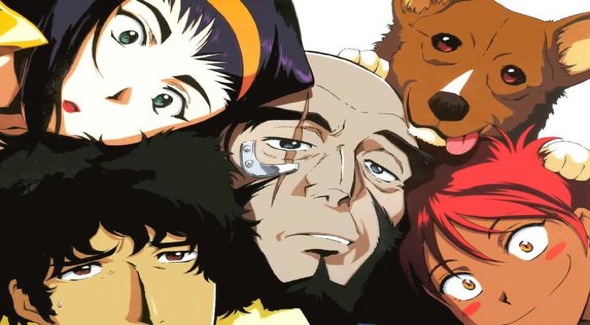
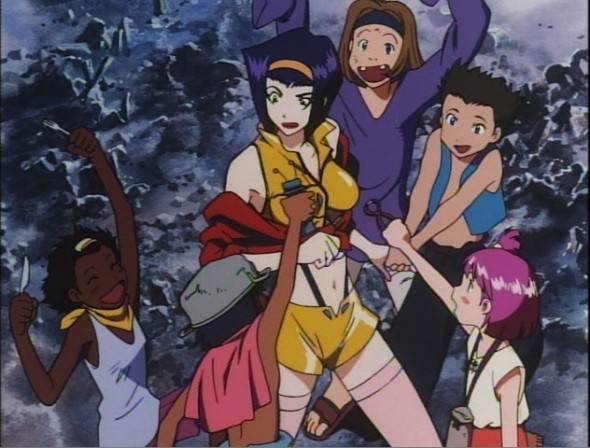
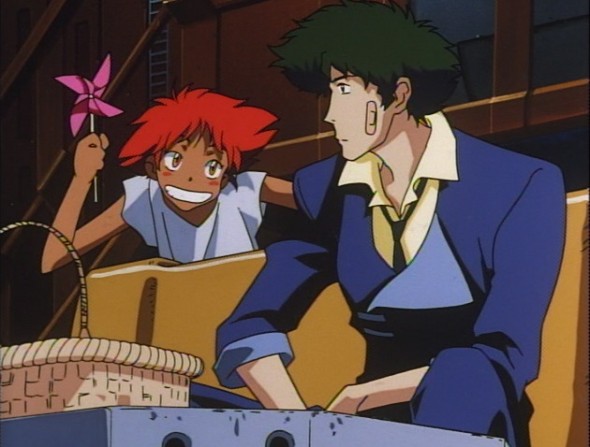
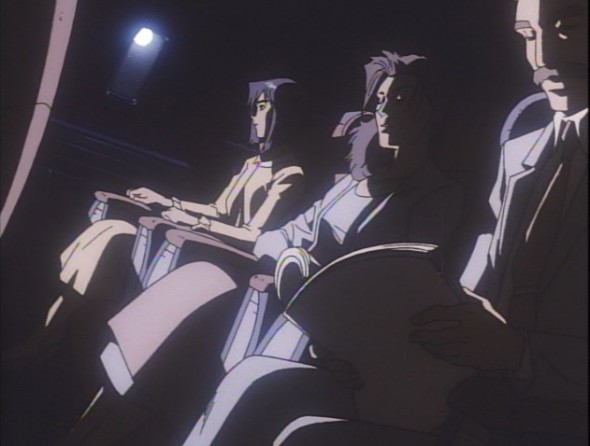
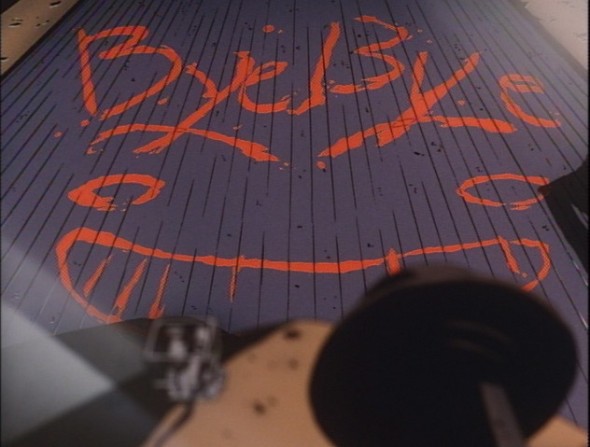
Wow. Mr.Stokes, you have shown me one of my favorite shows in a different light. The surrogate family of Bebop is done in other shows but so well in this one.
I knew I loved this show because it had so much emotion and depth of characters, which not a lot of people would associate with anime unless they’re expose to a lot of it.
Your closing thoughts on the show forced me to reflect on my own surrogate surroundings, and how my group of friends is constantly referred to as a family.
Great work. I need to watch Bebop again. It’s been a few years since I’ve seen it.
I don’t know anything about Cowboy Bebop, but when this popped in my RSS feed, I thought I recognized the lion fountain. Sure enough, later in the article you mentioned Singapore. Here it is:
http://www.flickr.com/photos/xini/364642502/
Speaking of CRT blur, the Star Wars holograms all had that as well. Maybe it’s just a deficincy of holo-technology?
Ha! I like it. Actually, I feel like there are two plausible exceptions. One is that it’s like the control panels with the buttons and dials on the original Star Trek: the writers just didn’t imagine a world where that particular technology had moved forward. The other – probably more likely – is that they realized that the audience would be more likely to accept the image as a projection of some kind if it had recognizable signs of image decay. In Star Wars, this is important because if we were looking at a perfect non-blurry miniature image of Princess Leia kneeling in front of R2D2, we’d be more likely to recognize the signs of image compositing, which would destroy our suspension of disbelief. Bebop doesn’t have this problem, but here it’s actually MORE important, because without the image decay how do you tell the difference between the hologram and “real life?” They would both just be drawings… the “fake” ones need to look different somehow.
Regarding your suggestion that the CRT blur is an effort to help the audience distinguish between the in-universe real/non-real images, I’ve seen the same special effect used in other anime when they depict events via televisions or computer monitors. I first recall the Patlabor movies using it and remember thinking at the time that it was a nifty device.
There is an in-universe explanation for poor radio and hologram quality as well, at least by the Rebel Alliance, to do with concealing identity from the Empire, which is ironically rather parallel to the real reason of concealing other give-aways…
Another lovely article that does a lovely and gut-wrenching episode justice.
Given your in-depth analyses of the Faye-Ed counterpointing, I’d be interested in your thoughts on the (to me) baffling moment right the title card where Faye . . . gives Ed angry mouth to mouth? Engages in anime’s most unappealing girl-on-girl kiss?
I noticed that in the shot where Ed shows up, the line of her neck and profile exactly mirror Faye’s. I liked it visually–it made Ed’s entrance feel that much sneakier having her suddenly pop up while also blending in seamlessly. She really is a weird kid. But maybe with this and the quasi-kiss, there’s also some other parallel–Faye passing on the burden of fruitlessly searching for her family? Faye as Sleeping Beauty (from her cold-sleep/Whitney storyline) literally waking a sleeping Ed up with a kiss?
Final thought: The final moments of the episode show Ed’s pinwheel mounted on the Bebop. I’ve read that in Japan pinwheels are placed on mizuko kuyo shrines for lost, stillborn, aborted, or deceased children. Mizuko kuyo means “water child.” Some relevance to Faye maybe(who’s often associated with water imagery and with whom water, memory and childhood seem to be linked–the water melting off her when she’s defrosted, her shower where she remembers everything, the home video coming via turtle messenger “from the deep,” the Merlion fountain, the fish hallucination from the mushroom episode?)
Here’s a link with pics of some such shrines, with thousands of pinwheels:
http://www.pbase.com/llewiscle/mizuko_kuyo_
Anyways thanks for another great write-up!
That is *super* interesting about the pinwheels! I was wondering about those.
As for the “kiss” thing – your guess is as good as mine. I mean, it’s closer to mouth to mouth than a kiss, because she’s obviously blowing. It’s probably an attempt to wake Ed up completely, and it probably would wake most people up at that. But as to why she would choose THAT method? It is a mystery. The symbolism you suggest could make sense, definitely… makes it kind of a tag-you’re-it moment, I guess.
You went exactly where I did with the idea of a surrogate family. Once you get this point, it gives a very different perspective that colors the rest of the series up to this point, especially regarding Faye. When she shows up, she’s annoying, bitchy, and basically bullies herself onto the Bebop. Retrospectively, though, it’s kind of sweet because you now know enough about her character to understand that she’s subconsciously searching for family, and more overtly looking for somewhere to “belong,” as she says to Edd.
So now you can look back at her decision to join up with Jet and Spike, which essentially takes just long enough for her to announce she’s going to take a shower. Just like that, she insinuates herself into the family, dysfunctional as it is. Earlier her complaining made her look like a spoiled bitch, but looking back, it appears more like familial banter, and her tiffs with Spike can seem more like a sibling rivalry (with a bit of sexual tension). The writers do a great job showing the crew growing as a family while the series progresses without overtly demonstrating it.
And this episode is damned well done. They’re at the point where they can say a great deal without any dialogue. I don’t have it where I can review, but I remember a great scene from this one where Jet yells something at Faye when she gets back to the Bebop, and she stops and gives him a look and…she just looks so lost. It’s something that should be just entirely beyond anime’s ability to pull off, but it’s great. Just like the scene with the eggs at the end-there are simply no words, so just stuff your face while you can.
I thought it was interesting that Faye’s accident was the same one that messed up so many other lives: The exploding of the gate that cracked the moon.
I don’t have your knack for writing or symbolism, Stokes, but I think there’s something here. We’ve seen a lot of lives affected by that event.
So the gate explodes, the moon gets a chunk taken out of it, and life changes. Debris rains down on the Earth.
– The surface becomes so riddled with asteroids hits that people have to take shelter underground. Cities are devastated, cultures and records are lost, including who Faye was, pre-accident.
– This also eventually drives most of the survivors to space, after new gates are built, leading to the massive colonization that we see throughout the series.
– That creepy immortal kid became that way due to being hit with residue from the explosion.
– Chessmaster Hex set up his whole long-game scheme because he was more concerned about gate safety than his superiors. Considering what happened with one of the gates being built, I’d say he was right to be concerned.
– Though he probably would have gotten distracted by something else, it is these asteroid hits that causes Ed’s father to abandon her in the first place. That’s at least two crew members direct affected by the change. Considering the major details of Jet’s and Spike’s lives revolve around crime, and that crime was probably caused by the frontier-environment of colonization, you could stretch and claim all four have been affected in some way by that explosion.
I need to think about this more…
I hate to burst your bubble but I don’t think Faye’s accident occured during the gate explosion. I believe the moon looks cracked because the widow of the craft is cracked. I also thought it occured as a resut of teh gate explosion; but when you see the moon in prior sessions, it isn’t cracked but is just missing a large chunk.
Joel, I think you’re right — but this doesn’t mean that Bobulus is wrong, exactly. Even if Faye’s accident isn’t the same event as the Gate Accident, it’s still thematically similar, and the way the moon is “cracked” by the window glass is meant to establish that connection. After all, why not have it be an image of the earth that gets distorted? Or the sun, or another spaceship, or the reflection of Faye’s own face? And if you look at the images of the damaged moon — I’ve got one of these up, on the post Wild Horses I think — the missing chunk is pretty close to the pie slice cut out by the broken glass. Roughly the same size, roughly the same location (although not exactly the same).
I was so excited when I came across your writing series about Cowboy Bebop and I’m still thoroughly enjoying these. Nothing particularly fascinating to add here, just appreciation from a film student who adores Cowboy Bebop for many of the reasons you’ve articulated and now for even more reasons I hadn’t spotted before. Makes me want to go back and rewatch the series all over again!
Excellent analysis…the most thorough treatment I’ve ever seen Cowboy Bebop receive. Now that I’m done waxing complimentary, I’d like to chime in some analysis as well. I’m not going to touch anything you’ve already provided because any divergence of opinion is minor and not nearly as thought out and thorough. I think one of the more interesting angles to the series expression of futility is that A) it unites each character in experiences (i.e. misery loves company) further establishing a bond which by series end is VERY strong and B) the futility exists because of the existence of the bond. As you correctly surmise, each character is more successful before becoming a member of this crack skeleton crew of failure.
I don’t know if the writing team chose to make them fail repeatedly deliberately to tear down the awesome convention of such ensemble shows (in real life…the ‘Oceans’ movies would be an example) or if they decided that each characters own dysfunction would sooner or later trigger the inevitable collapse. Yet, there is a sort of cohesion brought about by series end…I’ll await your analysis of “The Real Folk Blues” before expounding on that one, but because they always seem perched on the edge of the cliff ready to fall, the characters sort of have a binding tie working under pressure. What’s more is inspite of some unsavory characteristics amongst the leads (Faye and Spike in particular are capable of some pretty nasty acts) the audience finds themselves feeling commonality because at the end of the day, even though Spike is the essence of cool and Faye is a femme fatale in the making herself, they’re all human. They screw up, espically because of misjudgements caused by human conditions like arrogance or being impetuous and yet they return together…no matter how much say Faye has screwed the guys over or Spike has cost them financially in being reckless. It’s a persistant theme…but yeah, totally agree…even though it’s not really fleshed out, Faye CLEARLY was in love with Spike (by the way, I missed her running away in Jupiter Jazz as pertaining to Spike..but now that you mentioned it, that does make sense, in fact she’s impressed with him the moment she sees him). Yet in true Bebop fashion…he’s oblivious to her and….I’ll leave the rest to anyone has hasn’t seen the entire series to figure out. Great analysis and I’ll keep reading along…I’m also an amatuer anime watcher…I usually stick with proven ground (like this and Ghost in the Shell, which I’ll check and yes I’m asuming, but if you haven’t watched the Stand Alone Complex series I’d recommend it and I’d love to read your analysis of it, just FYI but it’s got intellectual ground and depths that I think are fascinating, including the changing of bedrock political outlook from the original film). If you’ve seen it..disregard and next time I’ve got nothing to do University-related, I’ll search out your analysis of it, too.
Whoops…I kind of said in real life or to finish the juxtaposition of ensemble example such as the ‘Oceans’ series…which I think is more poorly done, easier to predict (they always win in the end) than any high-end anime I’ve watched. Before anyone jumps on me…I just noticed that.
I know I’m 7 years late to the party here, but there is a beautiful symmetry to the fact that the first thing Faye does when she forces herself onto the Bebop is take a shower, and the last thing she does before she takes off (she thinks) for good, is… take a shower.